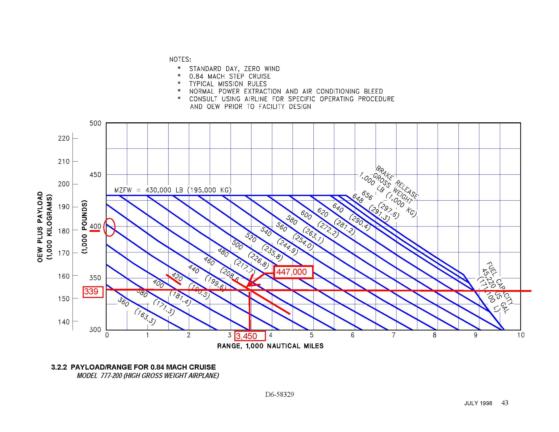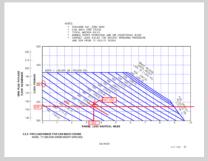
NavList:
A Community Devoted to the Preservation and Practice of Celestial Navigation and Other Methods of Traditional Wayfinding
Re: Flight 370
From: Gary LaPook
Date: 2014 Mar 23, 19:20 -0700
From: Gary LaPook
Date: 2014 Mar 23, 19:20 -0700
A closer look at the graph shows that the ranges derived from the graph allow about a 20,000 pound fuel reserve so the plane can certainly go farther. To see this, look at the zero range line and OEW of 400,000 pounds. You will see that the TOGW is 420,000 pounds, showing 20,000 pounds of fuel on board to go zero miles. This is the reserve and you can look at other combinations of OEW and TOGW that show about the the sane. See attached.
Since the fuel load was 108,200 pounds this allowed 20,000 pound reserve, about 23%, so the dry tanks range would have been about 4,200 NM, 4,800 SM.
gl
From: Gary LaPook <garylapook@pacbell.net>
To: garylapook@pacbell.net
Sent: Sunday, March 23, 2014 6:41 PM
Subject: [NavList] Re: Flight 370
Since the fuel load was 108,200 pounds this allowed 20,000 pound reserve, about 23%, so the dry tanks range would have been about 4,200 NM, 4,800 SM.
gl
From: Gary LaPook <garylapook@pacbell.net>
To: garylapook@pacbell.net
Sent: Sunday, March 23, 2014 6:41 PM
Subject: [NavList] Re: Flight 370
But it is not clear, since this is a planning document for airports to
use, whether this is with all fuel in the plane consumed or with the
fuel needed for required reserves not considered. In the U.S. a 45
minute reserve, in addition to fuel to reach an alternate, is required.
It makes sense that these graphs used less fuel than all on board since
you would not plan a flight to a destination that resulted with zero
fuel left on board. Using the minimum of a 45 minute reserve means that
flight 370 could have flown an additional 363 NM at a .84 mach cruise
speed.
For oceanic operations, U.S. regulations require a even larger reserve.
gl
For oceanic operations, U.S. regulations require a even larger reserve.
gl








